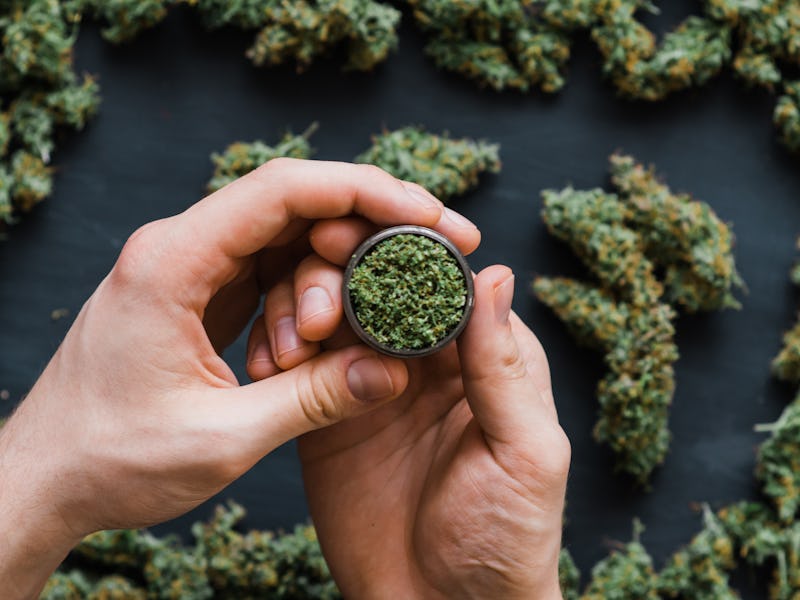Does weed hurt or help PTSD sufferers?
A new study tests medical cannabis as an alternate way of coping with PTSD.

Post-traumatic stress disorder (PTSD), a psychiatric condition linked to surviving or witnessing a traumatic life event, will affect around one in 10 Canadians at some point in their lives. PTSD can cause agitation, flashbacks, impaired concentration and memory, insomnia and nightmares, and these symptoms can increase the risk of substance abuse and dependence, depression, and suicide.
Many patients struggle to find adequate symptom relief from conventional treatments for PTSD including anti-depressant or anti-psychotic medications and psychological treatments such as trauma-focused cognitive behavioral therapy.
Unsurprisingly, many turn to alternative ways of coping — such as medical cannabis use. This is especially evident in the dramatic rise in the number of Canadian military veterans receiving government reimbursement for medical cannabis, with PTSD as a common reason for use.
The results of clinical trials testing cannabis as a PTSD treatment are pending. Previous research has linked cannabis use with poorer mental health in PTSD patients, but it’s unclear whether cannabis exacerbates PTSD symptoms, or if patients with worse symptoms are simply self-medicating more. Much of the existing evidence for cannabis as a PTSD treatment comes from patient reports of success.
As epidemiologists and substance use researchers, we have been exploring the relationship between cannabis and PTSD using readily available Statistics Canada mental health data.
In a recent study, published in the Journal of Psychopharmacology, we found that PTSD increased the risk of major depressive episodes among Canadians who didn’t use cannabis by roughly seven times, and suicidal ideation by roughly five times. But, among Canadians who did use cannabis, PTSD was not statistically associated with either outcome.
How cannabis works in the body
Substance use, including cannabis use, is common among trauma survivors. It’s easy to write off the drug as just a tool to briefly escape negative feelings at the risk of worsening longer-term symptoms. However, the relationship between cannabis and PTSD is more complex than it appears on the surface.
Our bodies naturally produce molecules called endogenous cannabinoids that fit into special cannabinoid receptors throughout the brain and body. This endocannabinoid system is involved in stabilizing bodily processes, including regulating many functions of the brain that tend to be affected after traumatic experiences, such as fear, memory, and sleep.
Certain components of the cannabis plant, including the well-known molecules tetrahydrocannabinol (THC, the component of cannabis that produces the high) and cannabidiol (CBD, the component of cannabis that won’t get you high but has potential for treating epilepsy, inflammation, nausea, and anxiety) are also cannabinoids because of their structural similarity to endogenous cannabinoids.
Even though THC and CBD aren’t naturally produced in our bodies, they can interact with the endocannabinoid system to influence a number of biological processes.
Research is still uncovering if and how cannabis works within the body to affect the course of PTSD. Brain imaging research suggests that patients with PTSD have an abundance of cannabinoid receptors but produce few endogenous cannabinoids to lock into them, meaning that supplementing the body with plant-based cannabinoids like THC might help some brain processes function as normal.
Reduced depression and suicide
Roughly one in four individuals with PTSD in the Statistics Canada survey data that we analyzed used cannabis, compared to about one in nine in the general population.
In our study, we used statistical models to quantify the relationship between having PTSD and recently experiencing a major depressive episode or suicidal ideation. We hypothesized that if cannabis helped mitigate symptoms of PTSD, we’d see a much weaker association between PTSD and these indicators of mental distress in the cannabis-using population.
Indeed, exploring the associations in this way while controlling for other factors (such as sex, age, income, other substance use, other mental health problems) supported our hypothesis.
In a follow-up analysis of the 420 individuals in the sample who had PTSD, we categorized cannabis use into “no use,” “low-risk use,” and “high-risk use” (meaning that they screened positive for cannabis abuse or dependence).
We found that low-risk cannabis users were actually less likely than non-users to develop a major depressive episode or to be suicidal, though there was a trend towards increased risk of both outcomes for the high-risk users.
Depressive traits were improved when people in the study were engaging in lower-risk cannabis use.
A promising new signal
People with PTSD are more likely to experience depression and suicidal ideation. However, our findings suggested that these indicators of mental health were improved when they were engaging in lower-risk cannabis use.
Our study has a number of limitations that prevent us from being able to understand whether cannabis is what’s causing the reduced association between PTSD, depression, and suicide.
For example, our data captures information covering participants’ experiences from the previous year, meaning we can’t actually decipher what came first: the cannabis use, the PTSD, or the major psychological episodes.
We didn’t have detailed information about how participants used cannabis. For example, the type and dose of cannabis they used, how often they used it, or how they consumed it. These details will be crucial to future research in this area.
Our study’s strength comes from its ability to describe patterns of PTSD symptoms and cannabis use in a large sample that’s considered to be representative of the Canadian population. Although our findings suggest that cannabis could be of possible therapeutic use in the treatment of PTSD, cannabis use is not without risks, including the development of cannabis use disorder.
We’ve uncovered a promising new signal on the potential of cannabis-based therapies, but we look forward to much work ahead in understanding how they might fit into PTSD and mental health treatment more broadly.
This article was originally published on The Conversation by Stephanie Lake and M-J Milloy. Read the original article here.